Designing an Efficient Surfactant–Polymer–Oil–Electrolyte System: A Multi-Objective Optimization Study
Abstract
1. Introduction
2. Materials and Methods
2.1. Chemicals
2.2. Full Factorial Design
- X1: mass concentration of SDBS, which varies between [0.01 w% and 0.08 w%].
- X2: mass concentration of kerosene, which varies between [20 w% and 50 w%].
- X3: mass concentration of PEG 1500, which varies between [5 w% and 20 w%].
- X4: mass concentration of NaCl, ranges from [0.1 w% to 2 w%].
- Y1: conductivity (mS/cm); Y2: turbidity (NTU); Y3: viscosity (mPa.s); and Y4: interfacial tension (mN/m).
2.3. Statistical Evaluation Criteria
3. Results and Discussion
3.1. Full Factorial Design Modeling
3.1.1. Influence of Independent Variables on the Conductivity
3.1.2. Influence of Independent Variables on the Turbidity
3.1.3. Effect of Independent Variables on the Viscosity
3.1.4. Influence of Independent Variables on the Interfacial Tension
3.2. Multi-Objective Optimization
4. Conclusions
Author Contributions
Funding
Institutional Review Board Statement
Informed Consent Statement
Data Availability Statement
Conflicts of Interest
References
- García-Mateos, I.; Pérez, S.; Velázquez, M.M. Interaction between Cetyl Pyridinium Chloride and Water-Soluble Polymers in Aqueous Solutions. J. Colloid Interface Sci. 1997, 194, 356–363. [Google Scholar] [CrossRef] [PubMed]
- Avranas, A.; Iliou, P. Interaction between Hydroxypropylmethylcellulose and the Anionic Surfactants Hexane-, Octane-, and Decanesulfonic Acid Sodium Salts, as Studied by Dynamic Surface Tension Measurements. J. Colloid Interface Sci. 2003, 258, 102–109. [Google Scholar] [CrossRef]
- Smitter, L.M.; Guedez, J.F.; Müller, A.J.; Saez, A.E. Interactions between Poly (Ethylene Oxide) and Sodium Dodecyl Sulfate in Elongational Flows. J. Colloid Interface Sci. 2001, 236, 343–353. [Google Scholar] [CrossRef]
- Gilanyi, T.; Wolfram, E. Interaction of Ionic Surfactants with Polymers in Acqueous Solution. Colloids Surf. 1981, 3, 181–198. [Google Scholar] [CrossRef]
- Barreiro-Iglesias, R.; Alvarez-Lorenzo, C.; Concheiro, A. Poly (Acrylic Acid) Microgels (Carbopol® 934)/Surfactant Interactions in Aqueous Media: Part I: Nonionic Surfactants. Int. J. Pharm. 2003, 258, 165–177. [Google Scholar] [CrossRef] [PubMed]
- Cosgrove, T.; Mears, S.J.; Obey, T.; Thompson, L.; Wesley, R.D. Polymer, Particle, Surfactant Interactions. Colloids Surf. Physicochem. Eng. Asp. 1999, 149, 329–338. [Google Scholar] [CrossRef]
- Minatti, E.; Zanette, D. Salt Effects on the Interaction of Poly (Ethylene Oxide) and Sodium Dodecyl Sulfate Measured by Conductivity. Colloids Surf. Physicochem. Eng. Asp. 1996, 113, 237–246. [Google Scholar] [CrossRef]
- Guo, W.; Sun, Y.W.; Luo, G.S.; Wang, Y.J. Interaction of PEG with Ionic Surfactant SDS to Form Template for Mesoporous Material. Colloids Surf. Physicochem. Eng. Asp. 2005, 252, 71–77. [Google Scholar] [CrossRef]
- Feng, Q.; Wang, M.; Zhang, G.; Zhao, W.; Han, G. Enhanced Adsorption of Sulfide and Xanthate on Smithsonite Surfaces by Lead Activation and Implications for Flotation Intensification. Sep. Purif. Technol. 2023, 307, 122772. [Google Scholar] [CrossRef]
- Feng, Q.; Yang, W.; Wen, S.; Wang, H.; Zhao, W.; Han, G. Flotation of Copper Oxide Minerals: A Review. Int. J. Min. Sci. Technol. 2022. [Google Scholar] [CrossRef]
- Puvvada, S.; Blankschtein, D. Molecular-thermodynamic Approach to Predict Micellization, Phase Behavior and Phase Separation of Micellar Solutions. I. Application to Nonionic Surfactants. J. Chem. Phys. 1990, 92, 3710–3724. [Google Scholar] [CrossRef]
- Nedjhioui, M.; Moulai-Mostefa, N.; Sellami, A.; Toubal, F. Contribution to the Study of the Combined Effects of Aqueous Solution Containing Surfactants and Biopolymers on Some Physical and Rheological Parameters. Desalination Water Treat. 2015, 56, 2739–2745. [Google Scholar] [CrossRef]
- Mongomery, D.C. Montgomery: Design and Analysis of Experiments; John Willy Sons: Hoboken, NJ, USA, 2017. [Google Scholar]
- Tahraoui, H.; Belhadj, A.E.; Moula, N.; Bouranene, S.; Amrane, A. Optimisation and Prediction of the Coagulant Dose for the Elimination of Organic Micropollutants Based on Turbidity. Kem. U Ind. 2021. [Google Scholar] [CrossRef]
- Bouchelkia, N.; Tahraoui, H.; Amrane, A.; Belkacemi, H.; Bollinger, J.-C.; Bouzaza, A.; Zoukel, A.; Zhang, J.; Mouni, L. Jujube Stones Based Highly Efficient Activated Carbon for Methylene Blue Adsorption: Kinetics and Isotherms Modeling, Thermodynamics and Mechanism Study, Optimization via Response Surface Methodology and Machine Learning Approaches. Process Saf. Environ. Prot. 2022. [Google Scholar] [CrossRef]
- Tahraoui, H.; Belhadj, A.-E.; Triki, Z.; Boudella, N.R.; Seder, S.; Amrane, A.; Zhang, J.; Moula, N.; Tifoura, A.; Ferhat, R.; et al. Mixed Coagulant-Flocculant Optimization for Pharmaceutical Effluent Pretreatment Using Response Surface Methodology and Gaussian Process Regression. Process Saf. Environ. Prot. 2022, S0957582022010102. [Google Scholar] [CrossRef]
- Kothari, C.R. Research Methodology: Methods and Techniques; New Age International: Shahjahanabad, India, 2004; ISBN 81-224-1522-9. [Google Scholar]
- Bouyahia, C.; Rahmani, M.; Bensemlali, M.; El Hajjaji, S.; Slaoui, M.; Bencheikh, I.; Azoulay, K.; Labjar, N. Influence of Extraction Techniques on the Adsorption Capacity of Methylene Blue on Sawdust: Optimization by Full Factorial Design. Mater. Sci. Energy Technol. 2023, 6, 114–123. [Google Scholar] [CrossRef]
- Oimoen, S. Classical Designs: Full Factorial Designs; STAT Center of Excellence: Dayton, OH, USA, 2019. [Google Scholar]
- Braima, N.; Maryam, A.N.A.; Odejobi, O.J. Utilization of Response Surface Methodology (RSM) in the Optimization of Crude Oil Refinery Process, New Port-Harcourt Refinery, Nigeria. J. Multidiscip. Eng. Sci. Technol. 2016. [Google Scholar]
- Nedjhioui, M.; Moulai-Mostefa, N.; Canselier, J.P.; Bensmaili, A. Investigation of Combined Effects of Xanthan Gum, Sodium Dodecyl Sulphate, and Salt on Some Physicochemical Properties of Their Mixtures Using a Response Surface Method. J. Dispers. Sci. Technol. 2009, 30, 1333–1341. [Google Scholar] [CrossRef]
- Maaze, M.R.; Shrivastava, S. Design Development of Sustainable Brick-Waste Geopolymer Brick Using Full Factorial Design Methodology. Constr. Build. Mater. 2023, 370, 130655. [Google Scholar] [CrossRef]
- Nedjhioui, M.; Moulai-Mostefa, N.; Morsli, A.; Bensmaili, A. Combined Effects of Polymer/Surfactant/Oil/Alkali on Physical Chemical Properties. Desalination 2005, 185, 543–550. [Google Scholar] [CrossRef]
- Nedjhioui, M.; Canselier, J.-P.; Moulai-Mostefa, N.; Bensmaili, A.; Skender, A. Determination of Micellar System Behavior in the Presence of Salt and Water-Soluble Polymers Using the Phase Diagram Technique. Desalination 2007, 206, 589–593. [Google Scholar] [CrossRef]
- Moulai-Mostefa, N.; Khalladi, R.; Nedjhioui, M. An Investigation into the Interactions between a Polymer and a Surfactant Using Viscosity, Conductivity and Surface Tension Measurements. Proc. Ann. De Chim. Paris 1914 2007, 32, 421–429. [Google Scholar] [CrossRef]
- Nedjhioui, M.; Moulai-Mostefa, N.; Tir, M. Effect of Some Physical and Chemical Properties on the Interactions between Biopolymers and Anionic Surfactants. Desalination Water Treat. 2015, 55, 3704–3712. [Google Scholar] [CrossRef]
- Yahoum, M.M.; Toumi, S.; Hentabli, S.; Tahraoui, H.; Lefnaoui, S.; Hadjsadok, A.; Amrane, A.; Kebir, M.; Moula, N.; Assadi, A.A. Experimental Analysis and Neural Network Modeling of the Rheological Behavior of Xanthan Gum and Its Derivatives. Materials 2023, 16, 2565. [Google Scholar] [CrossRef] [PubMed]
- Hadadi, A.; Imessaoudene, A.; Bollinger, J.-C.; Bouzaza, A.; Amrane, A.; Tahraoui, H.; Mouni, L. Aleppo Pine Seeds (Pinus Halepensis Mill.) as a Promising Novel Green Coagulant for the Removal of Congo Red Dye: Optimization via Machine Learning Algorithm. J. Environ. Manag. 2023, 331, 117286. [Google Scholar] [CrossRef]
- Tahraoui, H.; Belhadj, A.-E.; Hamitouche, A.; Bouhedda, M.; Amrane, A. Predicting the Concentration of Sulfate (So4 2-) in Drinking Water Using Artificial Neural Networks: A Case Study: Médéa-Algeria. Desalination Water Treat. 2021, 217, 181–194. [Google Scholar] [CrossRef]
- Zamouche, M.; Tahraoui, H.; Laggoun, Z.; Mechati, S.; Chemchmi, R.; Kanjal, M.I.; Amrane, A.; Hadadi, A.; Mouni, L. Optimization and Prediction of Stability of Emulsified Liquid Membrane (ELM): Artificial Neural Network. Processes 2023, 11, 364. [Google Scholar] [CrossRef]
- Bousselma, A.; Abdessemed, D.; Tahraoui, H.; Amrane, A. Artificial Intelligence and Mathematical Modelling of the Drying Kinetics of Pre-Treated Whole Apricots. Kem. U Ind. 2021. [Google Scholar] [CrossRef]
- Tahraoui, H.; Belhadj, A.E.; Hamitouche, A.E. Prediction of the Bicarbonate Amount in Drinking Water in the Region of Médéa Using Artificial Neural Network Modelling. Kem. U Ind. 2020, 69, 595–602. [Google Scholar] [CrossRef]
- Tahraoui, H.; Amrane, A.; Belhadj, A.-E.; Zhang, J. Modeling the Organic Matter of Water Using the Decision Tree Coupled with Bootstrap Aggregated and Least-Squares Boosting. Environ. Technol. Innov. 2022, 27, 102419. [Google Scholar] [CrossRef]
- Tahraoui, H.; Belhadj, A.-E.; Amrane, A.; Houssein, E.H. Predicting the Concentration of Sulfate Using Machine Learning Methods. Earth Sci. Inform. 2022, 15, 1023–1044. [Google Scholar] [CrossRef]
- Zamouche, M.; Chermat, M.; Kermiche, Z.; Tahraoui, H.; Kebir, M.; Bollinger, J.-C.; Amrane, A.; Mouni, L. Predictive Model Based on K-Nearest Neighbor Coupled with the Gray Wolf Optimizer Algorithm (KNN_GWO) for Estimating the Amount of Phenol Adsorption on Powdered Activated Carbon. Water 2023, 15, 493. [Google Scholar] [CrossRef]
- Singh, B.; Kumar, P. Pre-Treatment of Petroleum Refinery Wastewater by Coagulation and Flocculation Using Mixed Coagulant: Optimization of Process Parameters Using Response Surface Methodology (RSM). J. Water Process Eng. 2020, 36, 101317. [Google Scholar] [CrossRef]
- Lefnaoui, S.; Moulai-Mostefa, N. Investigation and Optimization of Formulation Factors of a Hydrogel Network Based on Kappa Carrageenan–Pregelatinized Starch Blend Using an Experimental Design. Colloids Surf. Physicochem. Eng. Asp. 2014, 458, 117–125. [Google Scholar] [CrossRef]
- Langevin, D. Polyelectrolyte and Surfactant Mixed Solutions. Behavior at Surfaces and in Thin Films. Adv. Colloid Interface Sci. 2001, 89, 467–484. [Google Scholar] [CrossRef] [PubMed]
- Goddard, E.D. Polymer—Surfactant Interaction Part I. Uncharged Water-Soluble Polymers and Charged Surfactants. Colloids Surf. 1986, 19, 255–300. [Google Scholar] [CrossRef]
- Harrison, I.M.; Candau, F.; Zana, R. Interactions between Polyampholytes and Ionic Surfactants. Colloid Polym. Sci. 1999, 277, 48–57. [Google Scholar] [CrossRef]
- Ghosh, S.; Moulik, S.P. Interfacial and Micellization Behaviors of Binary and Ternary Mixtures of Amphiphiles (Tween-20, Brij-35, and Sodium Dodecyl Sulfate) in Aqueous Medium. J. Colloid Interface Sci. 1998, 208, 357–366. [Google Scholar] [CrossRef]
- Sovilj, V.J.; Petrović, L.B. Influence of Hydroxypropylmethyl Cellulose–Sodium Dodecylsulfate Interaction on the Solution Conductivity and Viscosity and Emulsion Stability. Carbohydr. Polym. 2006, 64, 41–49. [Google Scholar] [CrossRef]
- Einhorn, H.J.; McCoach, W. A Simple Multiattribute Utility Procedure for Evaluation. Behav. Sci. 1977, 22, 270–282. [Google Scholar] [CrossRef]
- Dobrosz-Gómez, I.; Gómez García, M.Á.; Gaviria, G.H.; GilPavas, E. Mineralization of Cyanide Originating from Gold Leaching Effluent Using Electro-Oxidation: Multi-Objective Optimization and Kinetic Study. J. Appl. Electrochem. 2020, 50, 217–230. [Google Scholar] [CrossRef]
- Merta, J.; Stenius, P.; Pirttinen, E. Interactions between Cationic Starch and Anionic Surfactants III Rheology and Structure of the Complex Phase. J. Dispers. Sci. Technol. 1999, 20, 677–697. [Google Scholar] [CrossRef]

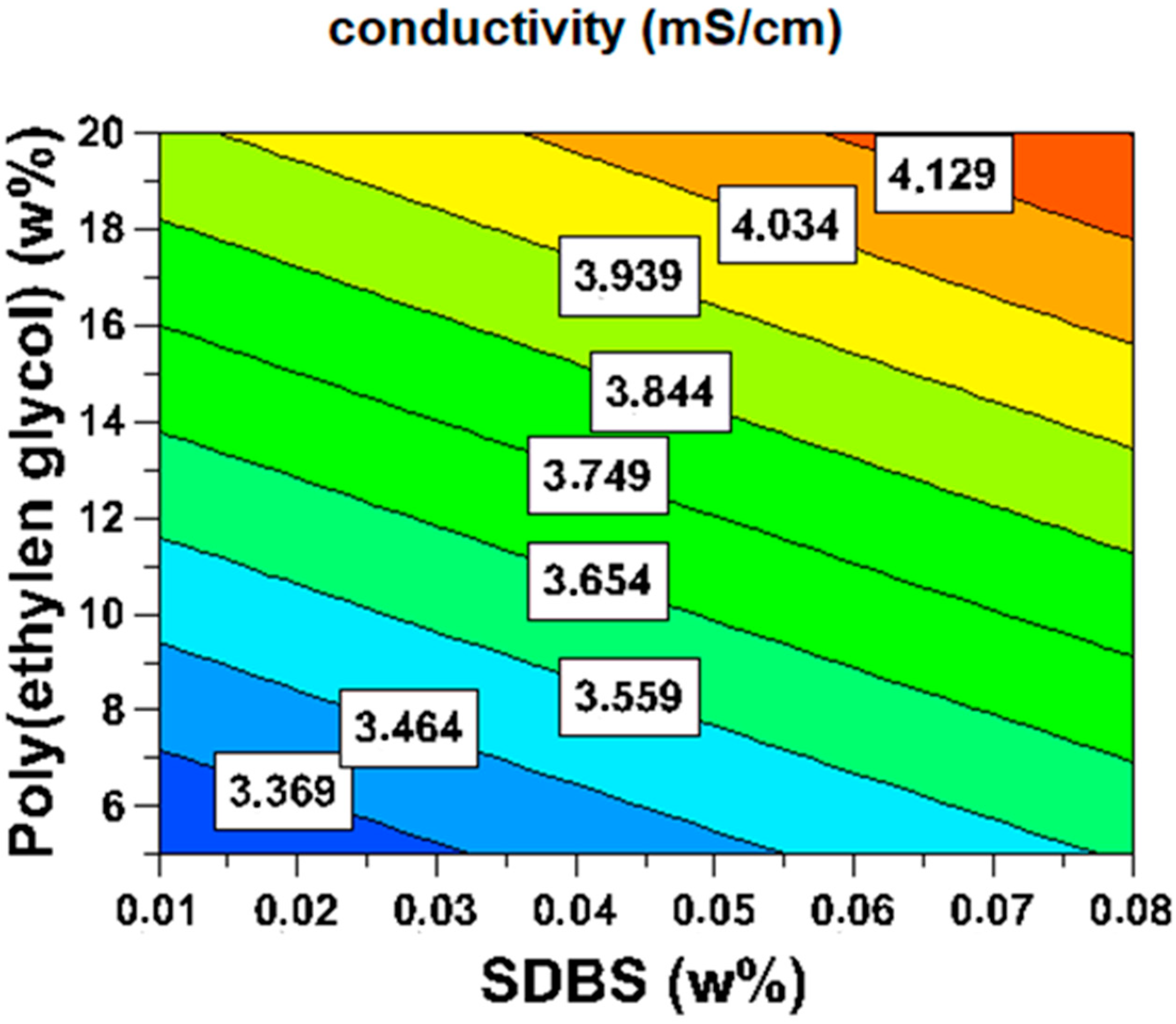
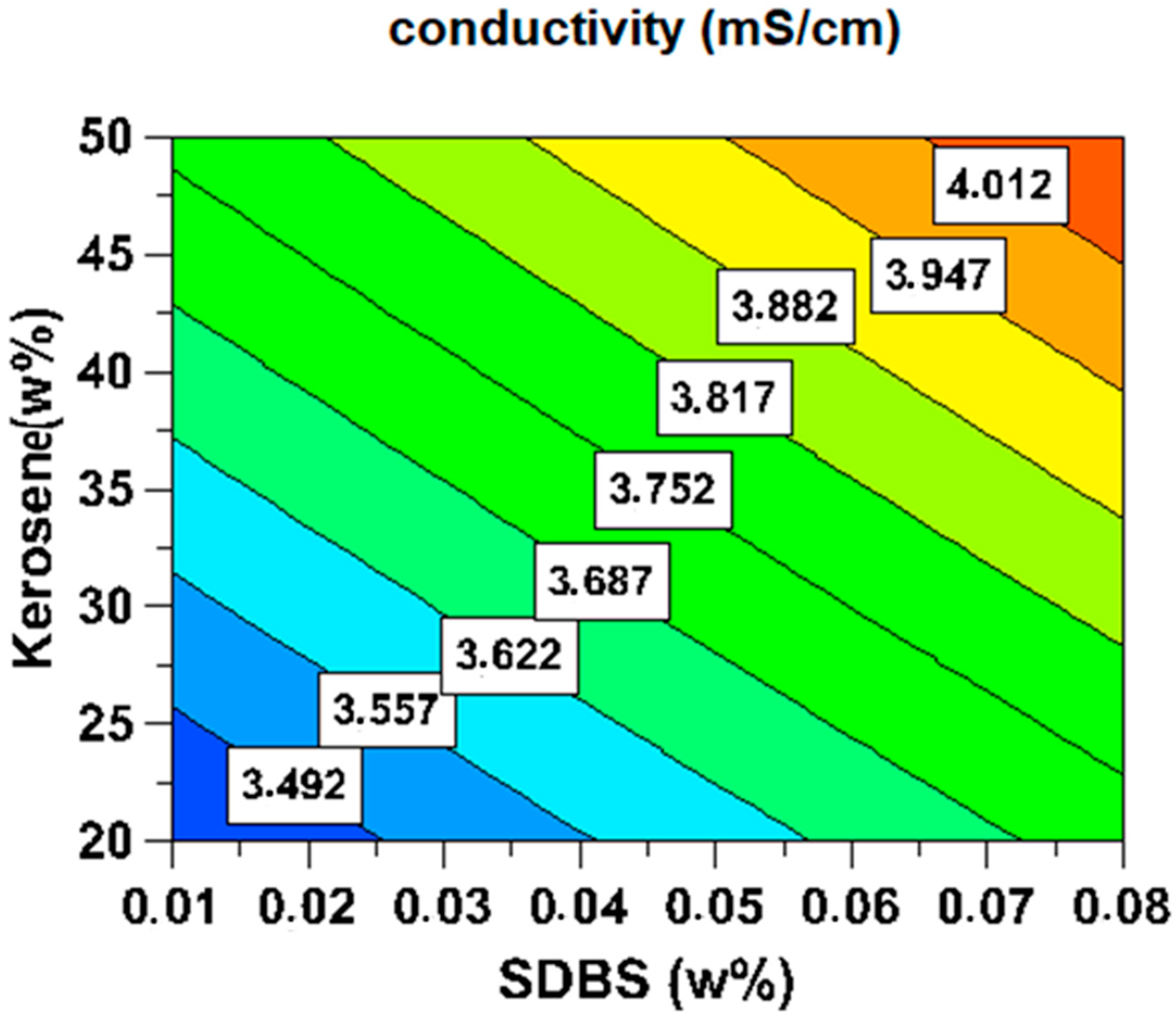
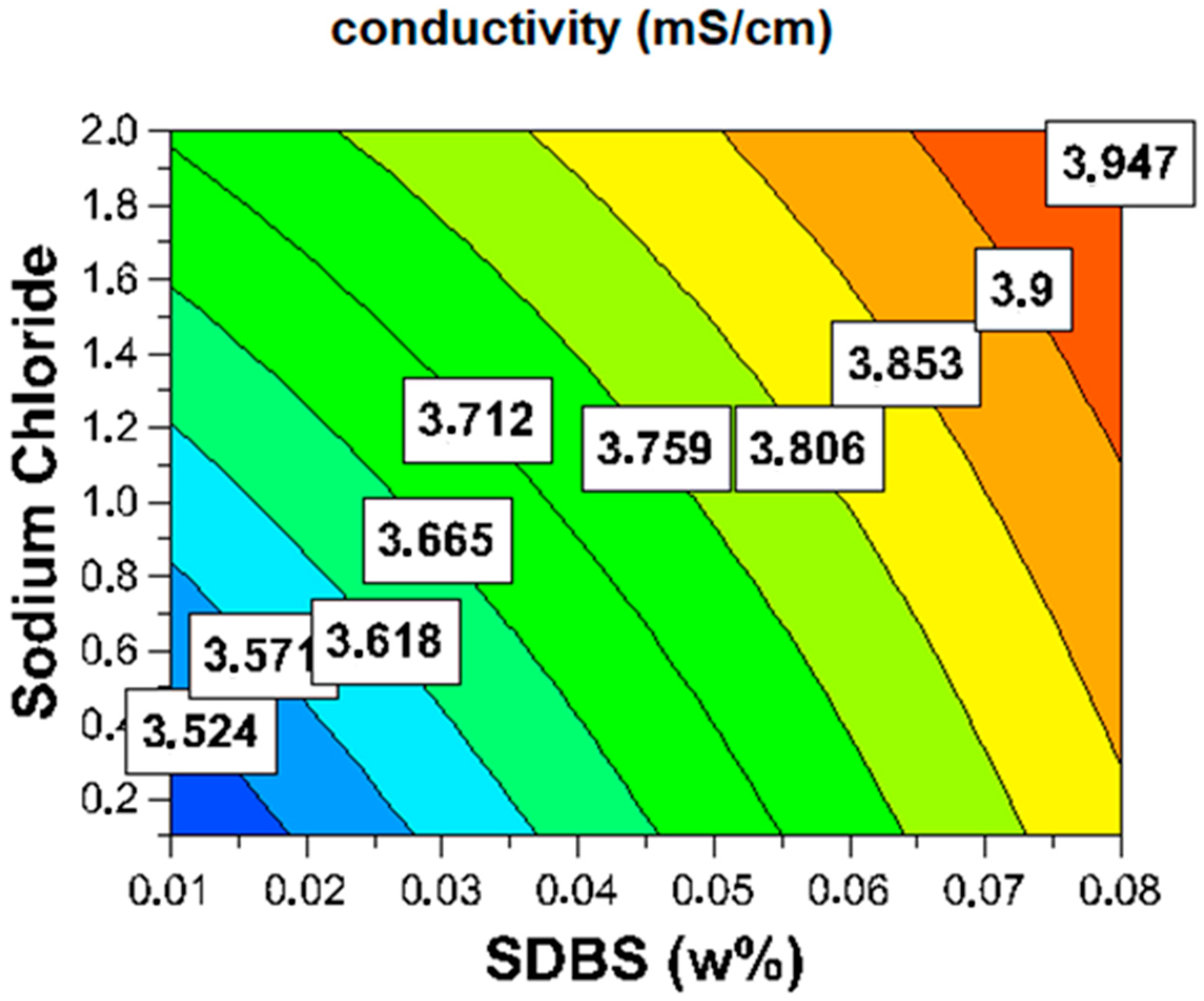

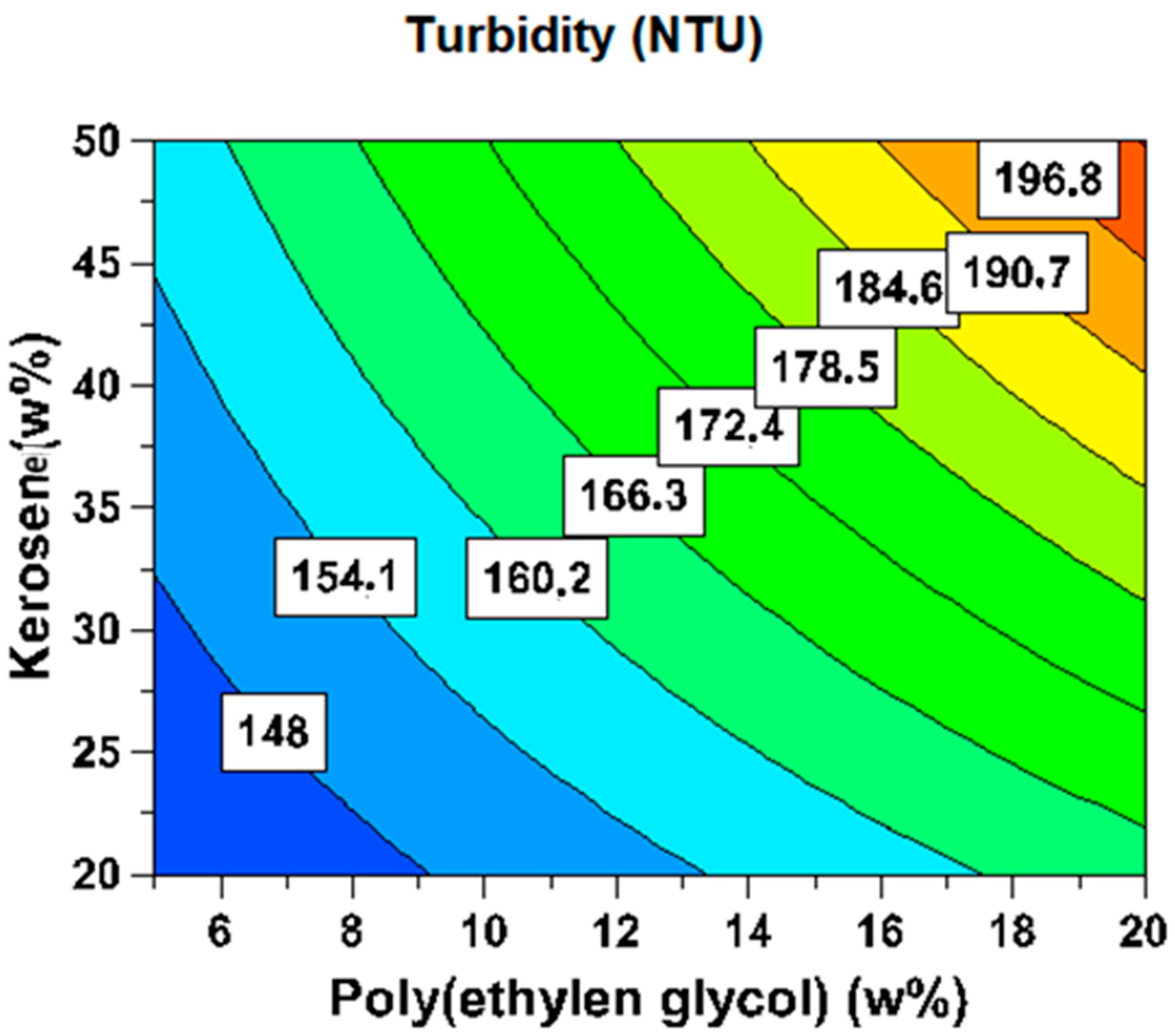


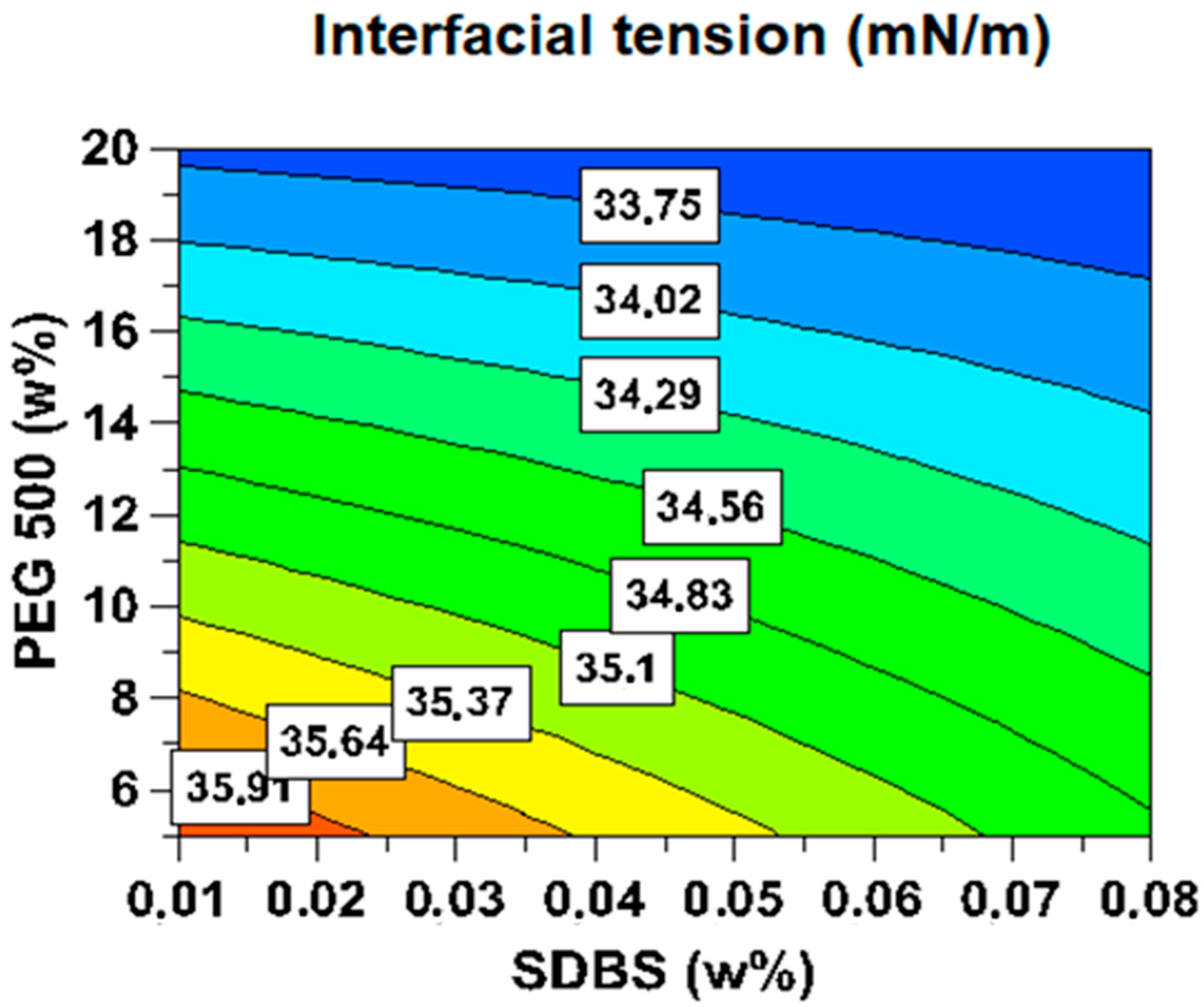

| Experience N° | SDBS (%w) | Kerosene (%w) | PEG (%w) | NaCl (%w) | Conductivity (mS/cm) | Turbidity (NTU) | Viscosity (mPa.s) | Interfacial Tension (mN/m) |
|---|---|---|---|---|---|---|---|---|
| 1 | 0.01 | 20 | 5 | 0.1 | 2.8 | 101 | 170 | 37.6 |
| 2 | 0.08 | 20 | 5 | 0.1 | 3.3 | 111 | 200 | 36.8 |
| 3 | 0.01 | 50 | 5 | 0.1 | 3.4 | 127 | 220 | 37.2 |
| 4 | 0.08 | 50 | 5 | 0.1 | 3.6 | 134 | 240 | 35 |
| 5 | 0.01 | 20 | 20 | 0.1 | 3.8 | 132 | 255 | 34.9 |
| 6 | 0.08 | 20 | 20 | 0.1 | 4.2 | 134 | 275 | 34.5 |
| 7 | 0.01 | 50 | 20 | 0.1 | 3.9 | 180 | 294 | 35.5 |
| 8 | 0.08 | 50 | 20 | 0.1 | 4.3 | 184 | 324 | 35.6 |
| 9 | 0.01 | 20 | 5 | 2 | 3.2 | 174 | 241 | 35.1 |
| 10 | 0.08 | 20 | 5 | 2 | 3.3 | 182 | 257 | 34.2 |
| 11 | 0.01 | 50 | 5 | 2 | 3.7 | 181 | 284 | 34.8 |
| 12 | 0.08 | 50 | 5 | 2 | 4.1 | 186 | 309 | 33.6 |
| 13 | 0.01 | 20 | 20 | 2 | 3.9 | 191 | 301 | 31.6 |
| 14 | 0.08 | 20 | 20 | 2 | 4.1 | 198 | 320 | 31.5 |
| 15 | 0.01 | 50 | 20 | 2 | 4.1 | 224 | 334 | 32.8 |
| 16 | 0.08 | 50 | 20 | 2 | 4.3 | 225 | 360 | 32.4 |
| 17 | 0.045 | 35 | 12.5 | 1.05 | 3.7 | 167 | 275 | 34.7 |
| 18 | 0.045 | 35 | 12.5 | 1.05 | 3.8 | 165 | 270 | 34 |
| 19 | 0.045 | 35 | 12.5 | 1.05 | 3.7 | 166 | 275 | 34.7 |
| I | Term | βi | Std Error | t Ratio | Prob > |t| | βi | Std Error | t Ratio | Prob > |t| |
|---|---|---|---|---|---|---|---|---|---|
| a. Conductivity (mS/cm) | b. Turbidity (NTU) | ||||||||
| 0 | Constant | 3.7473684 | 0.019427 | 192.89 | <0.0001 | 166.42105 | 0.293925 | 566.20 | <0.0001 |
| 1 | X1 | 0.15 | 0.021171 | 7.09 | 0.0001 | 2.75 | 0.320297 | 8.59 | <0.0001 |
| 2 | X2 | 0.175 | 0.021171 | 8.27 | <0.0001 | 13.625 | 0.320297 | 42.54 | <0.0001 |
| 3 | X3 | 0.325 | 0.021171 | 15.35 | <0.0001 | 17 | 0.320297 | 53.08 | <0.0001 |
| 4 | X4 | 0.0875 | 0.021171 | 4.13 | 0.0033 | 28.625 | 0.320297 | 89.37 | <0.0001 |
| 5 | X1 × X2 | 0 | 0.021171 | 0.00 | 1.0000 | −0.625 | 0.320297 | −1.95 | 0.0868 |
| 6 | X1 × X3 | 5.551.10−17 | 0.021171 | 0.00 | 1.0000 | −1 | 0.320297 | −3.12 | 0.0142 |
| 7 | X2 × X3 | −0.1 | 0.021171 | −4.72 | 0.0015 | 6.125 | 0.320297 | 19.12 | <0.0001 |
| 8 | X1 × X4 | −0.0375 | 0.021171 | −1.77 | 0.1145 | −0.125 | 0.320297 | −0.39 | 0.7065 |
| 9 | X2 × X4 | 0.0375 | 0.021171 | 1.77 | 0.1145 | −4.75 | 0.320297 | −14.83 | <0.0001 |
| 10 | X3 × X4 | −0.0625 | 0.021171 | −2.95 | 0.0184 | −2.625 | 0.320297 | −8.20 | <0.0001 |
| c. Viscosity (mPa.s) | d. Interfacial tension (mN/m) | ||||||||
| 0 | Constant | 273.89474 | 0.851815 | 321.54 | <0.0001 | 34.552632 | 0.078477 | 440.29 | <0.0001 |
| 1 | X1 | 11.625 | 0.928244 | 12.52 | <0.0001 | −0.36875 | 0.085519 | −4.31 | 0.0026 |
| 2 | X2 | 21.625 | 0.928244 | 23.30 | <0.0001 | 0.04375 | 0.085519 | 0.51 | 0.6228 |
| 3 | X3 | 33.875 | 0.928244 | 36.49 | <0.0001 | −0.96875 | 0.085519 | −11.33 | <0.0001 |
| 4 | X4 | 26.75 | 0.928244 | 28.82 | <0.0001 | −1.31875 | 0.085519 | −15.42 | <0.0001 |
| 5 | X1 × X2 | 1 | 0.928244 | 1.08 | 0.3128 | −0.09375 | 0.085519 | −1.10 | 0.3049 |
| 6 | X1 × X3 | 0.25 | 0.928244 | 0.27 | 0.7945 | 0.26875 | 0.085519 | 3.14 | 0.0138 |
| 7 | X2 × X3 | −1.5 | 0.928244 | −1.62 | 0.1448 | 0.43125 | 0.085519 | 5.04 | 0.0010 |
| 8 | X1 × X4 | −0.875 | 0.928244 | −0.94 | 0.3735 | 0.04375 | 0.085519 | 0.51 | 0.6228 |
| 9 | X2 × X4 | −0.625 | 0.928244 | −0.67 | 0.5197 | 0.10625 | 0.085519 | 1.24 | 0.2493 |
| 10 | X3 × X4 | −5.875 | 0.928244 | −6.33 | 0.0002 | −0.20625 | 0.085519 | −2.41 | 0.0424 |
| Final Equation in Terms of Code of Independent Variables | p | F | R2 | R2adj | RMSE |
|---|---|---|---|---|---|
| 1. Conductivity (mS/cm) | |||||
| 0.3097 | 0.9978 | 0.980502 | 0.9561 | 0.0847 | |
| 2. Turbidity (NTU) | |||||
| 0.3909 | 1.8553 | 0.9991 | 0.9979 | 1.2812 | |
| 3. Viscosity (mPa.s) | |||||
| 0.3883 | 1.8527 | 0.9963 | 0.9917 | 3.7130 | |
| 4. Interfacial tension (mN/m) | |||||
| 0.7241 | 0.6219 | 0.9816 | 0.9588 | 0.3421 | |
| J1 | J2 | J3 | J4 | J | |
|---|---|---|---|---|---|
| SDBS (%w) = 0.01, kerosene (%w) = 20, PEG (%w) = 5, and NaCl (%w) = 0.1 | |||||
| Experimental | 2.8 | 101 | 170 | 37.6 | 77.8500 |
| Predicted response | 2.8473 | 102.1710 | 174.1447 | 44.7650 | 80.98 |
| Error | 0.0473 | 1.1710 | 4.1447 | 7.1650 | 3.1300 |
| SDBS (%w) = 0.01, kerosene (%w) = 50, PEG (%w) = 5, and NaCl (%w) = 0.1 | |||||
| Experimental | 3.4 | 127 | 220 | 37.2 | 96.9000 |
| Predicted response | 3.3973 | 126.6710 | 217.3947 | 43.9026 | 97.8414 |
| Error | 0.0027 | 0.3290 | 2.6053 | 6.7026 | 0.9414 |
Disclaimer/Publisher’s Note: The statements, opinions and data contained in all publications are solely those of the individual author(s) and contributor(s) and not of MDPI and/or the editor(s). MDPI and/or the editor(s) disclaim responsibility for any injury to people or property resulting from any ideas, methods, instructions or products referred to in the content. |
© 2023 by the authors. Licensee MDPI, Basel, Switzerland. This article is an open access article distributed under the terms and conditions of the Creative Commons Attribution (CC BY) license (https://creativecommons.org/licenses/by/4.0/).
Share and Cite
Nedjhioui, M.; Nasrallah, N.; Kebir, M.; Tahraoui, H.; Bouallouche, R.; Assadi, A.A.; Amrane, A.; Jaouadi, B.; Zhang, J.; Mouni, L. Designing an Efficient Surfactant–Polymer–Oil–Electrolyte System: A Multi-Objective Optimization Study. Processes 2023, 11, 1314. https://doi.org/10.3390/pr11051314
Nedjhioui M, Nasrallah N, Kebir M, Tahraoui H, Bouallouche R, Assadi AA, Amrane A, Jaouadi B, Zhang J, Mouni L. Designing an Efficient Surfactant–Polymer–Oil–Electrolyte System: A Multi-Objective Optimization Study. Processes. 2023; 11(5):1314. https://doi.org/10.3390/pr11051314
Chicago/Turabian StyleNedjhioui, Mohammed, Noureddine Nasrallah, Mohammed Kebir, Hichem Tahraoui, Rachida Bouallouche, Aymen Amin Assadi, Abdeltif Amrane, Bassem Jaouadi, Jie Zhang, and Lotfi Mouni. 2023. "Designing an Efficient Surfactant–Polymer–Oil–Electrolyte System: A Multi-Objective Optimization Study" Processes 11, no. 5: 1314. https://doi.org/10.3390/pr11051314
APA StyleNedjhioui, M., Nasrallah, N., Kebir, M., Tahraoui, H., Bouallouche, R., Assadi, A. A., Amrane, A., Jaouadi, B., Zhang, J., & Mouni, L. (2023). Designing an Efficient Surfactant–Polymer–Oil–Electrolyte System: A Multi-Objective Optimization Study. Processes, 11(5), 1314. https://doi.org/10.3390/pr11051314










